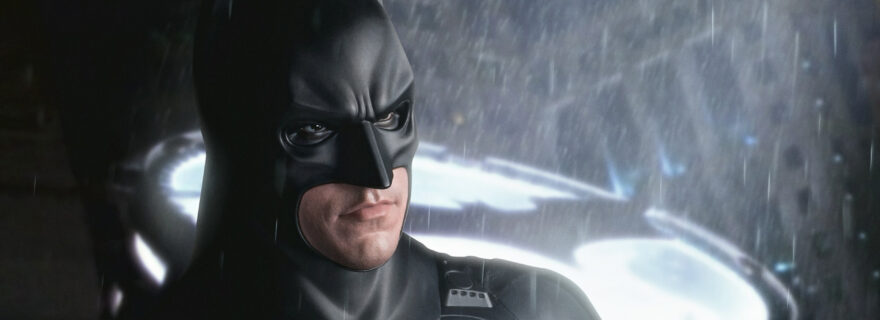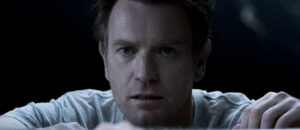On Saturday, April 20th, Warner Brothers, IMAX and Christopher Nolan collaborated on a celebration of the Dark Knight trilogy. The three films were screened on large format screens to sold-out audiences, including five venues equipped to handle IMAX 15/70 film prints as per the director’s preferred format.
Batman Begins (2005), The Dark Knight (2008), and The Dark Knight Rises (2012) helped usher in the current wave of blockbuster entertainment that treats comic book fare seriously in ways that few movies did before, elevating the scope of these productions to levels that continue to be attempted today.
Starting at noon with 90-minute breaks between, High-Def Digest had the chance to attend the event at Toronto’s Cinesphere, the world’s first purpose-built IMAX theater that has recently been restored to its glory, capable of running either a laser-projected 4k digital DCP or the 15 perforation/70mm IMAX film prints that built the company’s reputation.
2005’s Batman Begins served its title mission, giving audiences an origin story for the Caped Crusader that eschewed either the pop zaniness of the 1960s television show or the circus-like spectacle of Tim Burton’s vision. Christopher Nolan brought an almost documentary air to the piece, tying it to the operatic (Bruce Wayne’s parents gunned down outside a production of Die Fleidermaus) to the epic, with the Campbellian hero’s journey encompassing aspects from Eastern philosophy to antiestablishment zealotry.
As much as a success at the first film was, The Dark Knight truly established these movies as definitive, genre-busting canon. Heath Ledger’s final role as the Joker remains an indelible, horrifying bout of id that psychologically tears at expectations. He provides a unique and powerful reminder of the vagaries of evil in its purest, most insolent fashion. The horror of the Joker lies not in his plans, but his notion of chaos, whereby the very instruments of our downfall come from a mere scratch to humanity’s veneer. The corruption of idealism is palpable, transforming what could have simply been a stunning action film into something more provocative and profound.
The third film, The Dark Knight Rises, was always going to struggle to live up to the middle chapter, especially given its focus on a less-than-iconic baddie in the form of Bane, played with hulking authority by regular Nolan collaborator Tom Hardy. The third act is set a decade after the second film. It plays as a synergy of the previous two movies, merging their different tones and storylines into what upon closer examination is even more nihilistic. While relying upon a few too many switcheroo comic book tropes, the film’s cataclysmic elements have a scope and intensity that border on the apocalyptic. It may falter in comparison to its predecessors, but as part of the saga, it’s a worthy entry.
The greatest benefit of screening all three movies in a marathon fashion comes in finding the echoes and elements shared (or differing) between the various storylines. Christian Bale’s performance in particular is consistent in its excellence. The actor manages to use the gravel-voiced character to powerfully reflect those he comes into contact with. Michael Caine, Gary Oldman, Cillian Murphy, and Morgan Freeman are equal touchstones, while the likes of Maggie Gyllenhaal (replacing an over-her-head Katie Holmes), Anne Hathaway, Joseph Gordon-Levitt, Marion Cotillard, Ben Mendlesohn, and Aaron Eckhart elevate the material from mere child’s play into something that approaches levels of depth rarely seen in the comic book genre.
Batman IMAXified
The opportunity to see these movies screened on film again was a defining experience, but not necessarily because of the (exceptional) caliber of presentation we were treated to. Nolan is notorious for his evangelical adoration of celluloid, often mischaracterizing the advantages of its quality over modern digital capture and projection methods. As a kind of self-fulfilling way of putting a thumb on the scales, Nolan’s digital “prints” of these films are locked to the same 4k masters he used for home media. For Batman Begins, this isn’t a big deal, as the whole film was shot on 35mm to be projected with a 2.35:1 aspect ratio. During IMAX’s “DMR” process, the negative is digitally scanned, digitally enlarged, then printed back onto 15/70 film to be shown on large format cinemas.
Purity of the analog image? Hardly.
For The Dark Knight, Nolan shot some sequences, particularly the opening heist and the car chase, using IMAX cameras and film. This shifts the image size when projected from the rectangular 2.35:1 shape to the nearly square 1.43:1 aspect of proper (read: non-“Liemax”) IMAX format. The difference in size and clarity is enormous. The elements shot on IMAX film are captured almost grain-free with a luminance that’s breathtaking.
Yet here’s the rub: For home viewing, Nolan’s film switches not between 2.35:1 and 1.43:1, but only to 16:9, trading one thin rectangle for another with slightly more height. The difference is noticeable but nowhere near as impactful. Worse, and the true tragedy in terms of long-term preservation of this film, the DCP for theatrical presentation replicates that shift. Nolan refuses for entirely non-technical reasons to allow his digital presentation to equal the analog.
Thus, to see the last two films in the trilogy with the correct aspect ratio changes, the only way to do so, as of now, is on celluloid.
Without being able to directly compare the laser presentation (which would have obviated issues such as judder, particularly during the credits sequences), suffice it to say the films projected in true IMAX looked positively glorious. The Dark Knight Rises in particular looked immaculate. It likely came from newly-struck elements just for this marathon. With a significantly larger portion of the film shot for the bigger screen, its impact is even more hampered at home. Look at the opening bravura plane sequence and the framing of Bane falling towards the camera, and you’ll know what you’re missing if you’re one who has had the chance to see the framing as intended.
For all of Nolan’s fetishization of analog image, his soundtracks are uncompromisingly and gloriously presented in multichannel digital. Hans Zimmer’s drums in The Dark Knight are sublime. The iconic musical scores for all three movies, along with booming explosions and a galaxy of effects, rang wonderfully in the IMAX hall. Bane’s voice – which is emitted from the entire surround field and often lies just barely at the level of coherence (sometimes slipping over the edge) may be an exercise in obnoxiousness. Yet from the rumble of the “Bat” jet to the rush of flying bats, there’s plenty to revel in the sound work in these films.
Nolan provided a brief Q&A between movies two and three, once again providing technically unsound reasons to buttress his analog-first argument. (He talked of release prints being struck directly from the camera negative, forgetting all the CGI work that was incorporated in post-production.) Regardless, the most salient points regard the community nature of screening these movies. Whatever the vagaries of the technology, the entire point is for a group of people to experience these spectacles together, in the best presentation we can achieve, for the purpose of shared experiences. Setting aside the claims about format superiority, this is beyond any argument.
For those who recall, the premiere of The Dark Knight Rises was marred by a lunatic shooting back in 2012. That horror was a blight to this notion of shared cinematic experience, and I’m grateful that the actions of one disturbed and broken individual do not speak for the majority. The fact that this echoes the sentiments of the film is not lost on me. Not a screening goes by when I don’t think of those who died simply to take in a movie.
It’s a real privilege to be able to screen these films on a magnificent screen free from fear, reveling in the provocative storytelling and bombastic treatment of the Batman tale. It’s unclear if this event will be repeated, but given the inherent difficulty in seeing these films in the correct aspect ratio, any fan young or old who may have missed last weekend’s screening owes it to themselves to be on the lookout.
We’re treated these days to dozens of gigantic superhero spectacles that were borne in part by the work Nolan started. The originals remain touchstones of modern spectacular cinema and demand to be seen on the biggest canvas possible. The chance to experience the Dark Knight trilogy on the enormity of the IMAX screen proves to be a definitive celebration of their lasting legacy.




Jon
Have to respectfully disagree on the soundtrack for the Dark Knight Rises. Compared to the first two it was a deafeningly loud, boomy, distorted mess. Zimmer’s ‘score’ would frequently scream so loudly from the surrounds that it drowned out dialogue and other effects.
Josh Zyber
Christopher Nolan has a lot of really terrible ideas about sound design. He actually hates surround sound and prefers his movies be mostly stereo-focused. With each new movie, he also suppresses dialogue lower and lower in the mix until it’s barely audible below the deafeningly loud music and sound effects.
Jon
It’s definitely getting worse. After Inception he switched sound FX mixers from Lora Hirschberg to Gregg Landaker. That’s when things really started going off the rails. The audio for TDKR, Interstellar and Dunkirk is heavily clipped and distorted everywhere because of the extreme volume. In the theater it may not be so noticeable, but at home these movies sound like diarrhea. They’re like the cinematic equivalent of Death Magnetic.
Just my opinion…..
Judas Cradle
Gregg Landaker Won an Oscar for DUNKIRK – jusged by a jury of his peers, so…..
Josh Zyber
It’s pretty much a running joke that the sound mixing Oscar usually goes to the loudest movie. Mad Max: Fury Road also won that award, and the only “mixing” in that soundtrack amounted to pushing all the faders up to max and letting them ride that way the entire movie.
Jon
I agree with Josh that flashy soundtracks (or those to popular movies) are usually recognized by the academy over any real ‘excellence’ in their sound. Personally I think Mad Max has a decent soundtrack. Yes it’s loud, but it isn’t a hard clipped mess like TDKR and it never made me run for the remote because my ears were hurting.
As far as the whole idea that the academy award always goes to the ‘best’: Bohemian Rhapsody won Best Picture. Nobody put that one on their top ten list for 2018. Shakespeare in Love won over Saving Private Ryan. Whoopi Goldberg won an award for ‘Ghost’. The list goes on. Outside of Hollywood itself the Oscars don’t mean much nowadays. And this is coming from someone who used to watch them consistently.
Josh Zyber
Bohemian Rhapsody was only nominated for Best Picture. Green Book won. Your point still stands, though.
Jon
Whoops, my bad.
Al
Josh, we’ve heard you say that same thing about Fury Road, ad nauseam. It’s such bullshit.
Jason Gorber
AuthorIn the Cinesphere space it worked well – at home you def need full bandwidth I surrounds and centre to even make sense of half of it…
Luke Hickman
Funny story: I purchased tickets for this event the moment they went on sale, showed up early to get good seats for the all-day event, and went with a prime spot in the center of the theater right next to two seats marked as reserved. Who just so happens to have one of the two reserved seats? Jason Gorber.
I’m with him on the sound presentation from our screening. It was fantastic.
Last summer, I went to the same Toronto theater to catch a 10-year anniversary screening of The Dark Knight – but the quality of the older (flawed) print had nothing on the perfection of the prints that we saw on Saturday. Absolutely breathtaking.
Chris B
I love all 3 of these movies but the scene near the end of TDKR when all the (unarmed) police charge Bane and his crew who proceed to open fire resulting in the death of only 1 police officer is one of the most ridiculous things I’ve ever seen in a movie.
You have a mass of humanity charging well-armed mercenaries who proceed to open fire with automatic weapons and artillery and somehow miss 99.9% of their shots? Gimme a break.
I still enjoy the movie but every time I watch it this scene stands out as one of the most ridiculous things ever committed to film. Bane’s boys would have cut down every single one of those cops and the fight would have been over before it started.
Bolo
I found the entire film to have almost zero thought put into it.
And yes, I liked the first two.
Julian
Isn’t that just a case of ‘Stormtrooper marksmanship’, a very common trope in (non-R-rated) comic book films?
Chris B
I think it would be more forgivable if Nolan hadn’t constantly been striving for such a realistic tone. When everything else in the movie is so grim, gritty and serious, the scene sticks out to me as laughably bad.
It totally breaks the immersion (at least for me) and reminds us that we’re watching a bunch of people pretending as opposed to real events unfolding onscreen.
Josh Zyber
Not to mention that it’s just plain bad battle strategy. They’re attacking a building in the middle of a city square, yet they all come at it from only one direction. Nobody thought to maybe try coming around the other sides?
Chris B
Exactly. They’re police officers with training in tactics etc, they would know a straight charge is a bad idea. It’s pretty obvious Nolan just wanted to sacrifice logic for spectacle,
Julian
“Heath Ledger’s final role as the Joker”. Well, no, Terry Gilliam would disagree.
Jason Gorber
AuthorDidn’t he shoot PARNASUS before TDK?
Julian
No, because he passed away DURING the filming of ‘Parnassus’ 🙂 That’s why Gilliam had to resort to trickery with three replacement actors.
Judas Cradle
Ah, yes – the Panassai….or is it Parnassuses?
EM
“Porn asses”.